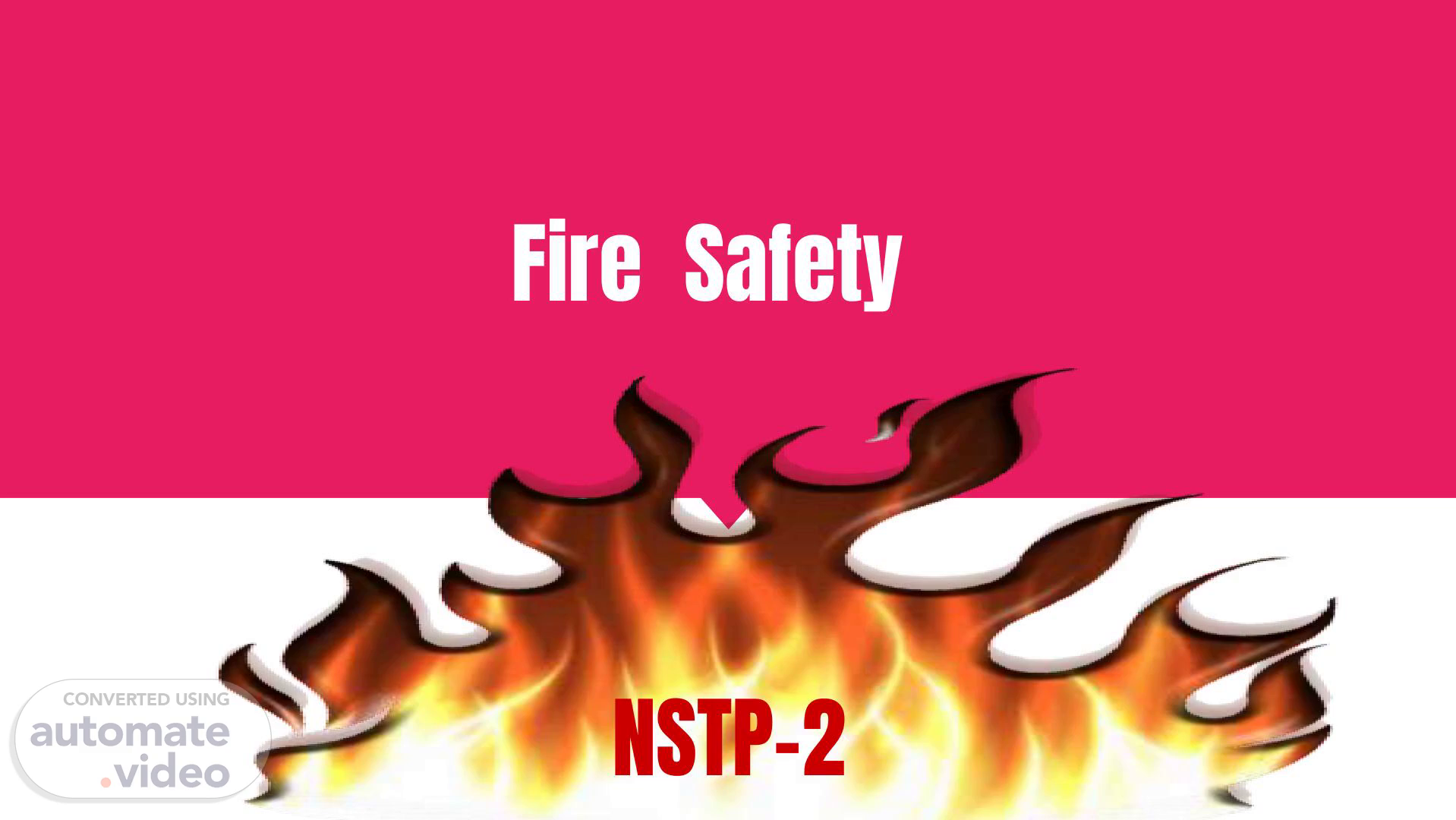Scene 1 (0s)
[Audio] Fire Safety NSTP-2. Fire Safety NSTP-2.
Scene 2 (5s)
[Audio] OBJECTVES: 1. To teach students how to avoid fires and fire-related injuries. 2. To raise awareness about fire deaths and injuries, as well as the common causes. 3. To educate students on their individual responsibility for fire safety and injury prevention..
Scene 3 (26s)
As of March 4.2025, the BFP reported a 43% decrease on Fire incidents in the first two months of the year. -Bureau of Fire Protection (BFP).
Scene 4 (37s)
In the first 64 days of 2025, 2,442 fire incidents were reported. This 43% decrease from 4, 316 incidents reported during the same period of 2024..
Scene 5 (48s)
Electrical issues are still the leading cause of fires. The BFP reminded the public to be and mindful, cautious especially when using electrical appliances.
Scene 6 (58s)
Fire Prevention Month The Philippine observes Prevention Month in March year. Fire.
Scene 7 (1m 5s)
The BFP encourages the barangay officials to participate in training sessions to improve their ability to respond t o fire.
Scene 8 (1m 13s)
The BFP residents measures potential also recommends that practice fire safety at home and report hazards..
Scene 9 (1m 20s)
Fire Code of the Philippines Republic Act No 9514 (RA 9514) outlines the country's fire safety standards..
Scene 10 (1m 28s)
[Audio] Thetopfirecausesinclude: Cooking(49%) OpenFlame(10%) Heating(9%) Incendiary/Arson(8%) Smoking(4%) *leadingcauseoffirefatalitiesPersonalvigilanceisthebestwaytoavoidandsurvivefires!.
Scene 11 (1m 53s)
[Audio] Cooking Fires pay attention to what you're cooking. If you leave the room, turn off the stove. Don't cook if you're sleepy or if you're impaired. Nearly half of all home fires originate in the kitchen..
Scene 12 (2m 6s)
[Audio] Reduce your Cooking Fire 1. Keep flammable items away from heat sources. Curtains, potholders, towels, clothing, etc. 2. Clean your stovetop frequently to avoid grease build up. 3. Keep flammable cleaners away from heat sources..
Scene 13 (2m 25s)
[Audio] Grease Fire This happens when your cooking oil becomes too hot. When heating, oils first start to boil, then they'll start smoking, and then they'll catch on fire. Most vegetable oils have a smoking point around 450°F, while animal fats like lard or goose fat will start smoking around 375°F. Always have the matching lid nearby! If you have a small grease fire you can smother it with the lid. NEVER PUT WATER ON A GREASE FIRE!.
Scene 14 (2m 57s)
[Audio] Smoking Related Fires Cigarettes can smolder for hours. Tips to avoid smoking related fires: 1. Don't smoke inside. 2. Discard smoking materials in a fire safe container. 3. Use a proper, heavy ashtray which won't tip easily. 4. Don't improvise! Smoking is the leading cause of fire deaths..
Scene 15 (3m 20s)
[Audio] Smoking Related Fires More tips to avoid smoking related fires: — Don't smoke in bed. — Don't smoke if you're tired, taking medications, or if you've been drinking or are otherwise impaired. — After a party, check indoor and outdoor furniture and cushions for smoldering cigarette butts..
Scene 16 (3m 41s)
[Audio] Candles Unattended candles are a leading fire cause. Candle safety tips: 1. Use flameless candles. 2. When you leave the room, blow out the candle. 3. Keep anything that could burn at least a foot away: curtains, clothes, paper, etc. 4. Don't set the candles on anything combustible. Fires can start when the candle burns down to the base..
Scene 17 (4m 6s)
[Audio] Electrical Safety 1. Do not overload electrical sockets. 2. Do not run cords under rugs or furniture. They can become worn, overheat, and cause a fire. 1. Avoid putting cords against walls or across doorways. 4. Use power strips equipped with overload protection. 5. Make sure all power strips and extension cords are tested and approved by a laboratory..
Scene 18 (4m 36s)
[Audio] Escape Route When the smoke alarm sounds, you may only have seconds or minutes to escape safely. Have a meeting place for everyone to gather outside. Plan two ways out, in case one way is filled with smoke or fire. Know your escape routes and practice them..
Scene 19 (4m 51s)
[Audio] Important Safety Elements Alarms Smoke Carbon Monoxide Fire extinguishers Residential Fire Sprinkler Systems.
Scene 20 (5m 1s)
[Audio] Smoke Alarms Breathing smoke can kill you! Smoke is toxic. If you must escape through smoke, get low and go under the smoke..
Scene 21 (5m 11s)
[Audio] Alarm Placement & Maintenance Make sure you can hear the alarm in every place in your home. They should be loud enough to wake you from sleep. Check them once a month. Change the batteries once a year. Replace them every 10 years..
Scene 22 (5m 27s)
[Audio] Carbon Monoxide Alarms Carbon monoxide (CO) is an invisible, odorless, colorless gas. There is no way to detect it without an alarm. Symptoms of CO poisoning mimic flu-like symptoms. If you're feeling symptoms, immediately move to an open window or go outdoors. High levels of CO can be fatal, causing death within minutes..
Scene 23 (5m 52s)
[Audio] Fire Extinguishers Know how to use them. Have them mounted in an obvious spot near an exit. When in doubt, get out!.
Scene 24 (6m 3s)
[Audio] Residential Fire Sprinkler Systems Fire sprinkler systems save lives and reduce damage to your property. — Only the sprinkler closest to the fire will activate, spraying water directly on the fire. — 90% of fires are contained by the operation of just one sprinkler..
Scene 25 (6m 22s)
[Audio] If you have a fire… 1. Report ALL fires to the fire department, even if you think you put them out! 2. Don't ignore alarms! 3. Even if your building has frequent alarms, you need to leave when they go off. 4. Once you're out STAY OUT! 5. Don't go back inside for possessions or pets. 6. Notify the fire department if anyone is unaccounted for. You never know when it could be a real fire..
